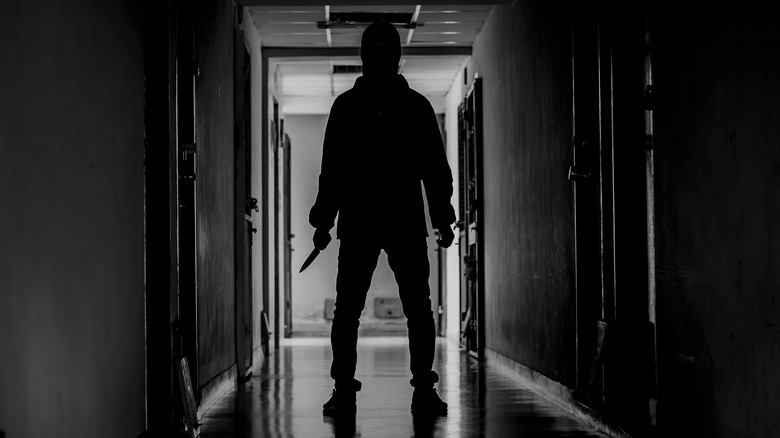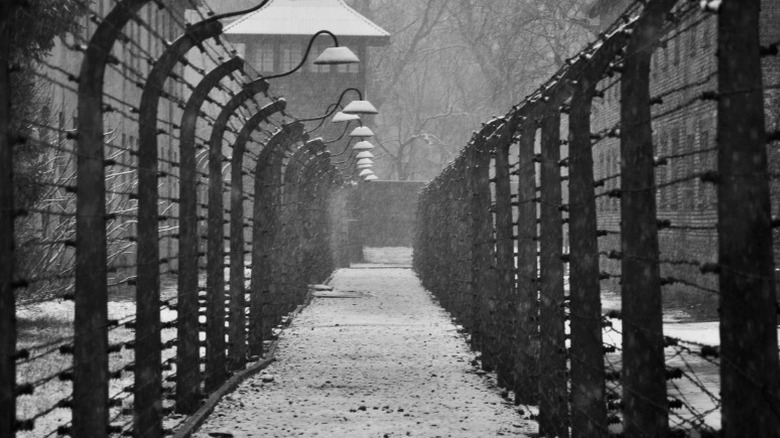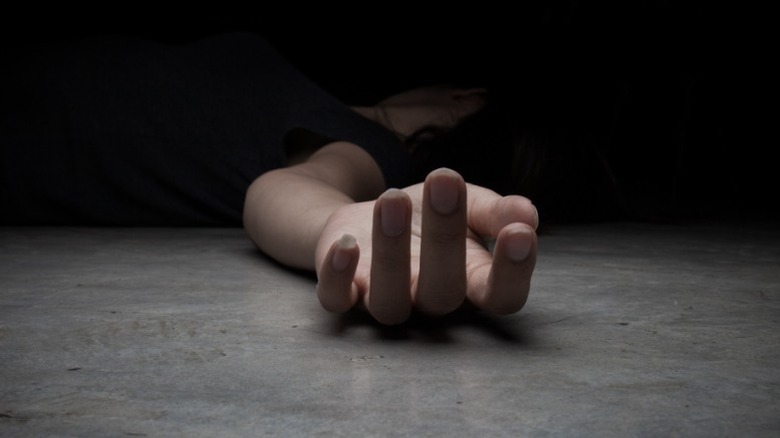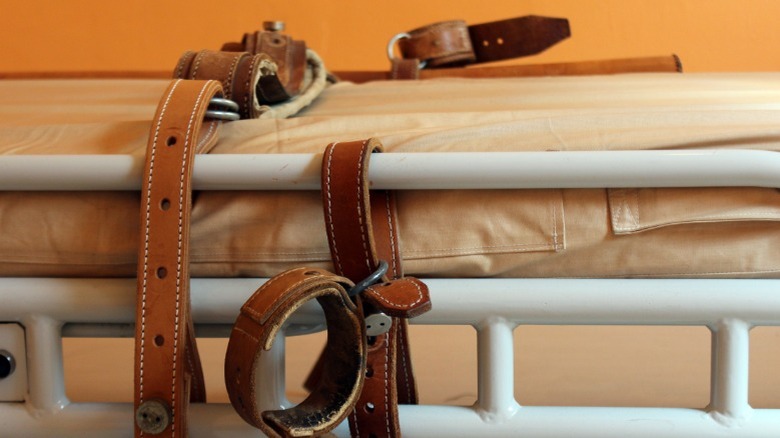Disturbing Details About The Serial Killer Fritz Honka
The United States and England don't exactly have the market cornered when it comes to notorious serial murderers. For every Ted Bundy and Jack the Ripper, there's a German equivalent that was just as brutal and equally as horrifying. Like their counterparts in other areas of the Western Hemisphere, German killers have inspired music and film and have been the subject of more than a handful of documentaries.
Those who follow true crime podcasts will surely be familiar with Peter Kurten, a serial murderer, rapist, and arsonist that terrorized Germany in the 1910s and 1920s. He was convicted of nine murders in 1931 and beheaded shortly after his trial (via Biography). The world got a fictionalized account of Kurten (known as the Vampire of Dusseldorf) in the 1931 Fritz Lang film "M" (per IMDb).
While not all of Germany's killers have been deemed worthy of inspiring film, there have been others whose savage deeds have been acted out on the big screen. The 2019 film "The Golden Glove" follows a serial killer that stalked and killed his prey in Hamburg in the early 1970s (per IMDb). Based on a novel of the same name, the Fatih Akin movie tells the tale of a man named Fritz Honka who killed sex workers.
The real-life Honka was perhaps more violent than he was depicted on the screen. He is known to have killed at least four women during a five-year stretch, carefully dismembering their bodies afterward. Though his number of casualties is far less than many other human monsters, his story is still shocking.
Honka's father died in a concentration camp
Like so many serial killers before and after him, Fritz Honka came from a troubled background. Crime + Investigation U.K. reports that Honka was born in 1935, one of nine children. The family was quite poor, leading to Honka's mother making the tough decision to have him live at an orphanage when he was young. Honka was able to make periodic visits to his family, but these were often met with violence at the hands of his father, who was employed as a firefighter. The patriarch experienced severe bouts of alcoholism and would beat Honka during those stays. Honka's father was also a communist, an attribute not very popular among the Nazi regime that took over Germany. Eventually, the elder Honka was rounded up with many other communists and sent to a concentration camp. It's reported that he died there.
Honka was bullied by the other children. He had a speech impediment and was routinely the butt of jokes. The troubles that plagued him as an adolescent followed him into adulthood — and he later experienced alcoholism just like his father.
If you or anyone you know needs help with addiction issues, help is available. Visit the Substance Abuse and Mental Health Services Administration website or contact SAMHSA's National Helpline at 1-800-662-HELP (4357).
A troubled marriage predated his murder spree
Fritz Honka left school and pursued a job as a tradesman. Crime + Investigation U.K. tells of how he first trained as a bricklayer. This endeavor was short-lived, as he soon discovered that he had a severe allergy to the materials used on the job. At 16, Honka took a job as a farmhand before landing a better job in a Hamburg shipyard when he was 21. It was here that Honka met Inga Bossleman. The two of them began dating when he was 22 and soon married. Like Honka, Bossleman was an alcoholic, and their experiences with the disease often caused arguments and violence between them. The couple did manage to have a child together, but their marriage wasn't meant to last. When Bossleman learned of an affair Honka had with another woman, she left him.
When he was in the throes of his unstable marriage, Honka lost his job at the shipyard. He managed to get a job there again as a night watchman but still frequented the bars in Hamburg. The alcoholism worsened. The few friends he had were slowly moving out of his life due to his drinking, and he began spending time with sex workers in an attempt to stave off the loneliness. Honka pursued women in the trade who would stay entire nights with him in exchange for alcohol and shelter. It was only a matter of time before the killer in him emerged. And sex workers became his target.
If you or anyone you know needs help with addiction issues, help is available. Visit the Substance Abuse and Mental Health Services Administration website or contact SAMHSA's National Helpline at 1-800-662-HELP (4357).
Honka killed his first known victim in 1969
Crime + Investigation U.K. details how Fritz Honka's first victim met her end. Gertrude Bräuer was a 40-year-old hairdresser that was struggling to make ends meet. To earn extra income, she was a part-time sex worker, which is how she met Honka. The two became acquainted in a Hamburg bar, and he paid her to accompany him home one evening in 1969. When dawn broke, he became enraged that she wouldn't have sex with him again. Honka lost control and strangled the woman to death. But this presented a problem for the killer. He assumed that she probably wasn't going to be missed for some time, but disposing of the body was going to be difficult, as he wasn't strong enough to drag her out of the apartment without attracting a lot of attention. What to do?
Honka decided to dismember her body and bury some of her remains. Perhaps scared of being caught in the act, he hid the rest of them in the attic of the apartment building. It took a year, but workers uncovered the parts of her that Honka had buried. She was identified, but no one thought of Honka as a suspect. The next time Honka lured a sex worker into his apartment, she was able to escape. This led to Honka being charged with rape. But it only deterred him from killing again for a brief period. By 1974, he was at it again, taking three more lives until his capture in 1975.
He was caught because of a careless neighbor
Fritz Honka's known victims after Gertrude Bräuer was 50-year-old Anne Beuschel (killed in August 1974), 57-year-old Frieda Roblick (killed in December 1974), and 52-year-old Ruth Schult (killed in January 1975). Crime + Investigation U.K. reports that each victim was a sex worker, and all were strangled in a rage by Honka. Honka dismembered their bodies in his apartment and stashed their remains in the attic. This storage method put off quite an odor after a while. Neighbors from the apartment building complained about the smells, leading police to question Honka. The killer told authorities that the scents were from the food his foreign neighbors routinely cooked. Police believed him, but after that, Honka used deodorizers to help mask the stench of decaying corpses.
One night, when Honka was at work at the shipyard, fate intervened most unusually. A fire broke out in his apartment building, caused by candles left unattended by one of his neighbors. Firefighters made a gruesome discovery in the attic — the remains of several women. But who killed them?
Police knew that anyone in the building had access to the attic. But they had their sites set on Honka. Maybe it was his prior arrest for sexually assaulting a sex worker or the fact that Bräuer's body had been found so close by several years before. Honka broke under pressure from the interrogation and confessed to killing the four women. He gave no motive for the killings but did tell police that Jack the Ripper told him to kill.
Honka was released from prison in 1993
Fritz Honka's confession should have been all that the police needed to secure a conviction. But Honka's attorney argued that Honka wasn't legally sane, citing his mention of acting on orders from Jack the Ripper (per Crime + Investigation U.K.). The defense strategy worked — Honka avoided being sent to a maximum-security prison with other rapists and murderers and was instead sent to a psychiatric facility for the criminally insane. But Honka didn't stay in the institution forever. In 1993, Honka secured a release from the hospital and was sent to live out the rest of his days in a nursing home. He was a resident there until he died in 1998 (via Deutsche Welle).
Aside from the 2016 Heinz Strunck novel "The Golden Glove" and the feature film that followed, Honka's deeds have been purveyed by pop culture in Germany in several other ways. Musician Harry Horror devoted an entire song to Honka in the 1970s (per Discogs), and German band Ost+Front released the song "Honka Honka" in 2000 (via Genius).





